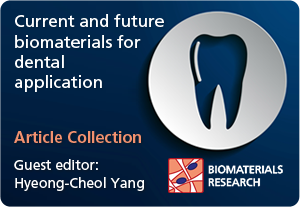
A variety of dental biomaterials have been developed to accommodate the clinical needs of dental patients. Newly developed dental biomaterials should be physically stable and biocompatible for their own purposes in the oral environment. Currently, the most frequently used dental materials include resin composites, titanium alloys, and zirconia. There is also increasing interest in materials for tissue engineering for both hard and soft oral tissue regeneration.
 An insightful new series Current and future biomaterials for dental application, published in Biomaterials Research and edited by Professor Hyeong-Cheol Yang from Seoul National University, focuses on the preparation, modification, biocompatibility and physical properties of current and future dental biomaterials. Most importantly, it discusses the application of dental stem cells in tissue regeneration.
An insightful new series Current and future biomaterials for dental application, published in Biomaterials Research and edited by Professor Hyeong-Cheol Yang from Seoul National University, focuses on the preparation, modification, biocompatibility and physical properties of current and future dental biomaterials. Most importantly, it discusses the application of dental stem cells in tissue regeneration.

A fascinating piece of original research by Seon et al. published in this series demonstrates that microwave-induced argon plasma effectively improves the biocompatibility of titanium surface, which is a well-established implantable material, especially for dental and orthopedic implants.
Another interesting research article by Kim et al. detected mycoplasma contamination in the stem cells from apical papilla, which were isolated from patients undergoing orthodontic therapy. This article highlights the importance of evaluating mycoplasma contamination and the elimination process in the use of stem cells from apical papilla for tissue engineering.

We hope that these articles and future additions to the series will continue to fuel interest in dental biomaterials and illustrate its importance for tooth regeneration.
Karen Cheng
Latest posts by Karen Cheng (see all)
- Hepatitis research and therapy around the globe – Q+A with editors and reviewers - 28th July 2016
- A new era for Inflammation and Regeneration: an Editor Q+A - 25th April 2016
- Little Fish, Big Role - 19th November 2015
Interesting and informative. Thank you for posting.
With all the new tech that has been around, its nice to know that the dental field is included in those new and improved applications that can lead to a more meaningful and wonderful SMILE…